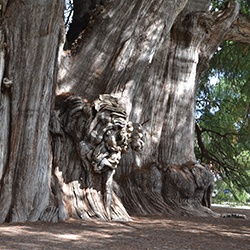
Mexico. Characteristics and cultures of a “magic” landscape
Conference of the International Carlo Scarpa Prize for Gardens 2023–2024
| - |
|---|
| Treviso, spazi Bomben |
At its Palazzo Bomben auditorium in Treviso, the Fondazione Benetton Studi Ricerche is organizing a first public meeting dedicated to Mexico and its landscapes, where the recipient of the International Carlo Scarpa Prize for Gardens 2023-2024 is located.
Mexican “responses” in terms of approaches to and projects for places and landscapes, especially in recent times, emerge as richly varied, also in relation to what, of late, amounts to a certain cultural over-exposure and to the co-existence of many different perspectives.
In Mexico, actions taken, directly and indirectly, to improve urban spaces, and projects in the fields of gardens, architecture and landscape explore and experiment with a sort of adaptation of natural structures to the complex and extreme realities of the country’s cities and its contemporary life in an attempt to reappraise the essentials of living in relation to nature, with all its real and symbolic, current and ancestral associations.
The practices employed since the mid-1900s reflect a pattern which is in a sense an alternative to, and in any case different from the western model in the diverse ways it addresses and deals with the relationship between the natural and built environments. With the acceleration and the globalisation of environmental emergencies in addition to other evidence of our fitful relationship with nature, the Mexican approaches, with their multiple cultural stratifications and dimensions strike us as more interesting than ever and rich in potential insights for the study and understanding of the nature of contemporary landscape, not only in Mexico and Latin America.
For these reasons, and in the light of a recent study trip to Mexico focussing on key themes of the next Carlo Scarpa Prize, the conference will be the first public event of the associated programme and will tackle the subject of the Mexican landscape from three main standpoints: 1. Garden and landscape cultures: ethnobotany and cultivation practices, projects; 2. Cities and regions: stories of integration and resistance; 3. The construction of a place: art, architecture, landscape.
Friday 19th May, 10 am-1.30 pm
Welcome address by Luigi Latini, the Director of the Foundation.Opening remarks by Patrizia Boschiero, the coordinator of activities associated with the Prize.
Mexican landscapes as described by Juan Rulfo and Italo Calvino, dramatized readings by Mirko Artuso, accompanied by Matteo Artuso on the violoncello.
Session 1. Garden and landscape cultures: ethnobotany and cultivation practices, projects
chaired by José Tito Rojo (botanist and garden historian, Granada University):
Alejandro de Ávila Blomberg (founding director of the Jardín Etnobotánico de Oaxaca), The ethnobotanical enchantment in the magic of the Mexican landscape;
Pedro Camarena Berruecos (architect and landscape architect, UNAM-Universidad Nacional Autónoma de México), Distinctive features of the Mexican landscape. The Pedregal, from its cuenca to the Espacio escultórico;
Mario Schjetnan (architect and landscape architect, GDU-Grupo de Diseño Urbano, Mexico City), Contemporary landscape projects in Mexico.
Discussion.
Friday 19th May, 3 pm-7.30 pm
Session 2. Cities and regions: stories of integration and resistance
chaired by Anna Lambertini (architect and landscape architect, Florence University):
Alejandro Villalobos Pérez (architect and archaeologist, Facultad de Arquitectura, UNAM), The pre-Hispanic landscape and surviving example (online contribution);
Massimo Rossi (historical geographer, Fondazione Benetton Studi Ricerche, Treviso), Tenóchtitlan-Mexico City: its representation in historical cartography in Europe and in the maps of natives;
Alberto González Pozo (architect, UAM-Universidad Autónoma Metropolitana, Mexico City ), Ancestral beauty, current risks and the chances of survival of the chinampas of Xochimilco (online contribution);
Amaya Larrucea Garritz (architect and landscape architect, Facultad de Arquitectura, UNAM), The Pedregal de San Ángel as an example of the protection and defence of landscape;
Aldo Aymonino (architect, professor of architectural and urban planning, Iuav University, Venice), Abstraction and figuration in Mexican art and architecture.
Discussion.
Saturday 20th May, 10 am-2 pm
Session 3. The construction of a place: art, architecture, landscape
chaired by Juan Manuel Palerm (architect, Las Palmas University, Gran Canaria):
Fernanda Canales (architect, Fernanda Canales Arquitectura, Mexico City), Contemporary Mexican architecture: significant experiments in relation to landscape;
Juan Ignacio del Cueto (architect, director of the Faculty of Architecture, UNAM), The University City of Mexico project: architecture, art and life in the Pedregal;
Gabriela Carrillo (architect, Taller Gabriela Carrillo, Mexico City), Architecture and landscape in Mexico. The project;
Julio Gaeta and Luby Springall (architects, Gaeta Springall Arquitectos, Mexico City), Landscape projects for the city;
Mauricio Rocha Iturbide (architect, Taller de Arquitectura-Mauricio Rocha, Mexico City), The Anahuacalli Museum. Remodelling, expansion and construction of spaces in the Pedregal.
Discussion and conclusions.
